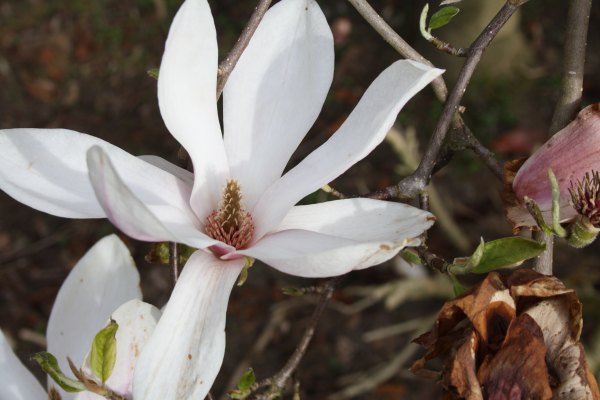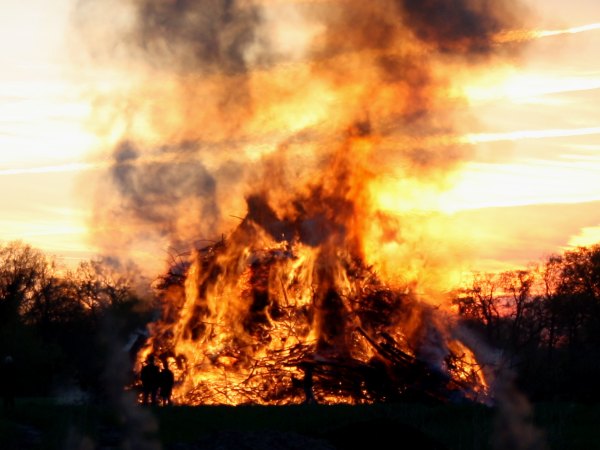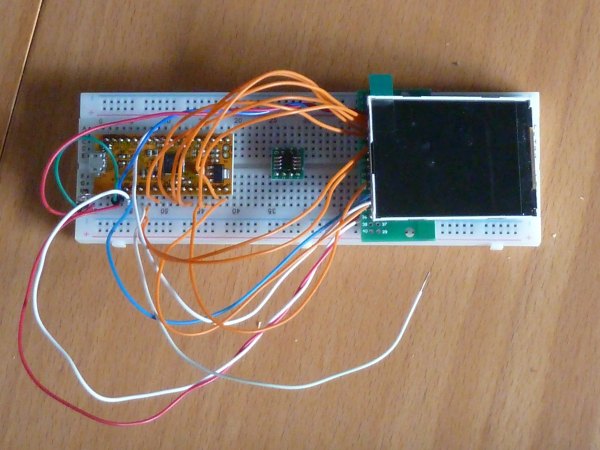Snow on our magnolia
There were some stories that we were going to get a lot of snow during the past night. I measured about 2cm of snow at some places,
but there was no snow on the streets. Some other parts in the North and the
center of the country did get some snow cover of about 9cm. Although it kept
on snowing during the day, sometimes quite a lot, most of the snow melted away
before noon. Last month we had more sunshine than ever before since its being
measured. In the center of the country about 250 hours of sunshine. It was also
extremely dry. In the past days all flowers on our
magnolia opened. This morning there was some snow on most of the flowers.
In the afternoon, I found many flower leaves on the ground. I am afraid that
the flowers will turn brown in the coming days, also because the temperature
is going to drop below zero in the coming nights. The picture taken below is
taken in the morning.

Museum of the Future
In the afternoon, I visited Museum of the
Future, which is organized by Planetart that also organizes
GOGBOT. The museum is the same building were
Warp
Technopolis is found and also where the last GOGBOT festival was held that
I visited on Sunday, September 12, last year.
Some of the exhibits are still there from the last GOGBOT festival. Some of the
rooms were not open and not all installations seemed to work. The enterance
was free.
I also went to see the exhibition 'Work' at
Fotogalerie Objektief with photographs by Ebo Fraterman. Impressive.
I recieved the book Grid Index written by Carsten Nicolai in English and published by Die Gestalten Verlag in March
2009, ISBN:9783899552416, which I had bought on Sunday, March 20, 2022 from Librairie
au point du jour for € 104.19. I spend some time looking through all
the grid patterns in the book. In some way interesting but not very well
organized.
-5.8° Celsius
Last night, the temperature at Twenthe Airport
dropped to -5.8° Celsius, which breaks the previous record of -5.1°
from 1996. No surprise that (almost) all flowers on our
magnolia truned brown overnight. On March 22,
the temperature went up to 19.2°.
My family from my mothers side is coming from an area in Germany just South of
the Rhein and not far from the border with the Netherlands. On wikipedia there
is a
collection of Tranchot Maps. These are maps that were made by
Jean-Joseph
Tranchot and later by Friedrich von Müffling. Tranchot was appointed by Napoleon to map the
Rhineland topography in the earliest nineteenth century.
I have come to the conclusion that it is possible to create irregular grids of
squares and equilateral triangles all having the same length. Because there are
also constellations of triagles and squares that can be replaced by a regular
hexagon or a dodecagons with sides of the same length, it is possible to include these
as well under certain conditions. The idea is to start with a regular triangle
grid and mark each edge either with a zero or a one, such that around each
vertex there are one of four patterns:
- All edges are marked with zeros.
- There are two opposite edges marked with ones and the other four with
zeros.
- The edges are marked alternating with zeros and ones.
- There are two opposite edges marked with zeros and the other four with
ones.
Now it is possible to 'enlarge' each edge marked with a one to a square and
fill the remaining 'open' areas with equilateral triangles.
Dodecagon
I created an animation to show that there are two ways a
dodecagon can
be filled with twelve equilateral triangles and six squares.
|
|
UPDuino
I went to TkkrLab and discussed with
someone how is involved with developing the MCH2022 badge how I could do something with the FPGA. At this moment, it
is not very easy to program FPGA on the badge because the firmware for the
badge is not suitable for it yet. Because UPDuino has the same FPGA, we have decided that it is better to start
working with it. I got an ILI9341 Z240IT008 LCD and two PSTAM64h ICs. I will
also get a connector for the LCD.
Irregular grids of sqaures and equilateral triangles
Below an irregular grid of squares and equilateral triangles is shown. It is
made by taking a
regular grid of dodecagons and triangles and fill the dodecagons with
squares and triangles at random according to one of the two
ways this can be done. Something similar could also have been done with
a regular grid of
dodecagons, hexagons and squares where the hexagons are filled with
triangles or a
regular grid of hexagons, squares and triangles where some of the partly
filled dodecagons are filled with the other alternative.
UPDuino workshop
Yesterday and tonight, I studied the materials of the FPGA workshop based on the UPDuino that I attended on Saturday,
September 28, 2019. I remember that I did not get very far that day,
because I had not installed the tools and had some problem installing (and
compiling) them at that day. I never did something with it. The
Basic FPGA development gives a good introduction to Verilog focussing on
the UPDuino. Yesterday, I made some adaptations to the examples with the RGB
LED. This evening, I uploaded the example with the DS18B20 digital temperature sensor and spend some time
studying the code. Earlier today, I also had a look at Clash, a functional hardware description language, that can generate
Verilog code.
More irregular grids
In the past week, I spend some time on a program generating more irregular
grids of squares and equilateral triangles. To night, I worked on some
code to visualize the output of the program.
Planting herbs
This afternoon, I dug and leveled the flowerbed on the right side of the path
to the front door of our house, to sow some herbs
that we bought in Elburg last year. I first
sowed Garden marigold (Calendula officinalis) on the border with the neighbors. We wanted to sow
the rest with poppy (Papaver somniferum). I noticed that the seed resembled those that are
found on the Dutch 'Maanzaad' roll. I tried to sow them neatly, but didn't pay
enough attention and before I knew it the bag was empty. Then we decided to
sow the rest with milk thistle (Silybum marianum). I had too many of those, so I planted a few elsewhere
in the front yard as well. It wasn't until I got in that I realized the poppy
seeds looked like the seeds on 'Maanzaad' rolls because these are poppy seed
rolls.
New flowers
Below a picture of one of the new flowers that have opened on our magnolia. It seems that not yet all flowers had opened when the
temperatures suddenly dropped on April 3. In the right
corner the remains of a flower that has turned brown.

On the MCH2022 badge there is a
ESP-PSRAM64h memory chip connected to the FPGA. It would be nice, if there
would be some example Verilog code to communicate with this chip. It can
contain 64Mbit (equivalent to 8Mbyte) of data. You communicate with through a
Serial Peripheral Interface (SPI). It also supports the Quad SPI Type 1
interface (also called QPI), which uses four data lines for addresses and
sent/receive data. The Hackaday Sypercon 2019 Badge has an FPGA which is
connected to two ESP-PSTAM64h chips. Verilog code to implement cached memory
is available in qpi-cache folder of the code repository.
Even more irregular grids
I have found another method to generate even more irregular grids with squares
and equilateral triangles. I have invented a method to encode these, but have
not yet written a program that could generate these kind of encodings. I still
have to figure out the rules. The grid below is made from the text from the
text area below. The letters 'a', 'b', 'B', 'c', 'd', and 'D' generate
triangles in all possible orientations. The 'B' and 'D' are in the same
orientation as 'b' and 'd' except that 'B' and 'D' are above the line. The
letters 'e', 'f', and 'g' generate squares in all possible orientations. The
letter '-' stands for a horizontal move without any thing being drawn.
Reopening Het Goed
Today, thrift store Het Goed reopened their
shop in Enschede at a new location, closer to the city center. Last Monday, I
visited the previous shop, which was along a road that I take when biking to
work, for a last time. It was very busy in the shop. I only had a look at the
books section. I felt that it was a little smaller than in the previous shop.
At 13:15, I bought the book Aldo Van Eyck, Humanist
Rebel: Inbetweening in a Post-war World written by Liane Lefaivre and Alexander Tzonis in English and published by 010 Publishers in 1999,
ISBN:9789064503917, for € 6.80.
CyberSaturday: LED Strips by Mitch Altman
I went to the CyberSaturday LED Strips by Mitch Altman event held at TkkrLab. I already know how to program LED strips. I went there to see
Mitch Altman to give
the workshop. I liked his
presentation. He explained everything very well, demonstrating many things.
See here for the presentation and
materials. I bought an Arduino kit + LED
strip for € 13.37, which also include a small breadboard, some
wires, resistors, LED's and some buttons, that were not used during the
workshop.
Easter bonfire
In the evening, Conny and I went walking because
along the Helweg there was a pile of pruning waste about five to six meters
high. When we walked along it, there were no signs that it was going to be
lit as a Easter
bonfire. We walked to the end of the Helweg (Hell road) and returned on
our steps. We noticed that more people had gathered. We waited on some bench
along the road and around 20:22 was saw some flames. We walked a little closer
and saw the sun set behind the pile, while it was getting on fire. Below, one
of the pictures we took. On the left of the base of the pile, the silhouette of
two adults can be seen.

FemtoRV
I read that Matthias Koch is
trying to implement FemtoRV32, a minimalistic RISC-V CPU developed by Bruno
Lévy, on the FPGA of the MCH2022
badge. He is going to implement the driver for the LCD screen and the
serially attached external RAM.
FPC-40P connector
I spend the evening soldering wires to a FPC-40P connector at TkkrLab in order to connect an IL19341 LCD display (attacted to a
Z240IT008) with my UPDuino. For this
I looked at the
ILI9341 datasheet to figure out which wires I should connect. I checked if
the backlight was working. This is next step in trying to write some software
for the FPGA on the MCH2022 Badge.
Connecting LCD screen
This afternoon, I attempted to connect an ILI9341 LCD screen to
my UPDuino with the connector that I made
last Tuesday. This how I intended to connect the wires from
the UPDuino to the pins of the FPC-40P connector (using the UPduino v3.0 pin connection scheme):
(Pin 1-4 not connected)
GND: White wire on pins 5, 13, 16-24, 37, 39, and 40
3.3V: Red wire on pins 5, 7, 12, and 38
25: White (silver) wire on pin 8
28: Orange wire on pin 9
11: White (copper) wire on pin 10
23: blue wire on pin 11
36: Orange wire on pin 15
26: Orange wire on pin 25
27: Orange wire on pin 26
31: Orange wire on pin 27
32: Orange wire on pin 28
34: Orange wire on pin 29
37: Orange wire on pin 30
38: Orange wire on pin 31
42: Orange wire on pin 32
3.3V: Red wire on pin 33 (through 50Ω resistor)
GND: Blue wire on pins 34-36
This is how it looked:

It did not work, except for the backlight of LCD. I was not really surprised
that it did not work, as I knew that one small mistake would be enough. I also
might have made an error in the LCD mode selection.
Border poles
This afternoon, Conny and I continued our search for
border poles. We first made a stop to search
for trigonometric point 259308 which is located at X-RD 265003.7806 Y-RD
473066.1554 552° 14' 04.79124" North, 6° 59' 51.38138" East. At 14:54, we
found it close to the red circle we found on January
30 when we first searched for it. We did not find any markings to
identified it as we did at some of the others. We found the following border
poles:
- At 15:41, pole 51.
- At 15:51, pole 51-I.
- At 15:58, pole 51-II laying by the (opposite) side of the path.
- At 16:05, pole 52 and marke stone Steen ten oosten het Bergs Venne.
- At 16:20, what could be the remains of pole 52-I.
- At 16:34, pole 53.
We did not find pole 52-II. We walked back through Bergvennen, a fenland
nature area. On the way home, we did see border poles 48 from a large distance.
At home, I found that there was also a marke stone, Steen bij de Voelendijk, near border pole 51, possible because it
disappeared below the soil.
Book
At 17:28:20, I bought the book A Heartbreaking Work of Staggering Genius written by Dave Eggers in English and published by Vintage Books in 2001,
ISBN:9780375725784, from thrift store Het Goed
for € 1.30.
The Nemesis Machine
Yesterday evening, I wanted to see the opening of the The Nemesis Machine by Dr Stanza at the Museum of the
Future. The announcement of the opening on Facebook said that it would
start at 19:30, but when I arrived there, I heard that the real opening started
at 20:00. Because I wanted to be home before 20:30, I decided to go home.
Today, I bought a free ticket, which stated 14:00. I arrived shortly before
14:00, but a little after 14:00, I discovered a sign saying the museum only
opens at 15:00. I walked around the city and visted the exhibition Ateliers '93 op bezoek at Concordia. It has works by
seven artist from the artist collective Ateliers'93 from Hengelo. Quite
interesting. I liked the What are you looking for works by Jose Maria
Verstappen and also the collage by Gertie van Neunen with the last three lines of the poem
On A
Distant Prospect of Eton College by Thomas Gray:
Thought would destroy their paradise.
No more;—where ignorance is bliss,
'Tis folly to be wise.
Around 15:08, I arrived at the Museum of the Future again only to be told that
the room with The Nemesis Machine was not open yet and that it might still take
an hour for it to open. I decided to pay a short visit to TkkrLab. At 17:33, I returned and saw The Nemesis Machine. I was not very
impressed. It was basically old PCBs decorated with some LEDs that blink in a
seemingly random pattern, based on signals from IoT sensors in Portugal
according to the description on the wall. Random patterns, even if based on an
external source (which might be interesting in itself), are not interesting as
they contain no information just like a boring constant signal. Signals only
become interesting when they have a pattern.
This months interesting links
Home
| March 2022
| May 2022
| Random memories









